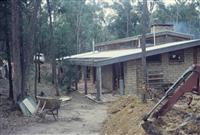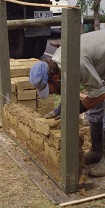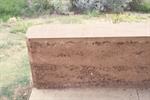Learn the complete process to planning and building a mud brick building
 Develop an understanding of building with mud, primarily mud bricks. This course takes you step by step through the building process, showing how to plan a building, sorting through permits and other legalities, doing the site works & foundations, different construction techniques, laying bricks, frames & roofs, installing services, wall finishes and more.
Develop an understanding of building with mud, primarily mud bricks. This course takes you step by step through the building process, showing how to plan a building, sorting through permits and other legalities, doing the site works & foundations, different construction techniques, laying bricks, frames & roofs, installing services, wall finishes and more.
- Build your own mud brick building (house, shed, garage, garden room).
- Build a mud brick cubby house with your children.
- Use mud to create garden walls, seats, paving or other things.
- Learn other ways of building with mud as well.
COURSE STRUCTURE AND CONTENT
Mud Brick Construction aims to develop an understanding of how to approach building with mud bricks. Mud brick building is also known by the alternative name 'adobe'. There are other ways of building with mud brick apart from 'adobe'. These will be covered briefly in this course. For the novice, there is not a lot which can go wrong if you choose to build with mud brick.
The content of each of the 10 lessons is outlined below:-
1. Scope of Mud Brick
-
What is Mud Construction (Adobe, Pise).
-
Advantages of Earth Construction (Cost savings, Self satisfaction, Aesthetics, Eco friendliness, Health benefits).
-
History of earth construction.
-
Pise (Rammed Earth).
-
Mud Brick.
-
Wattle and Daub.
-
Cob.
-
Cinva Ram.
-
Cement Stabilisation.
-
Bituminous stabilisation.
-
Mortar.
-
Variations in Earth Building Techniques.
-
Appropriate Soils for Earth Construction.
-
Finding Resources.
2. How to make a mud brick
- Testing and working with different soils.
- Soil Tests.
- Steps in making a brick.
- Plasticity Soil Test.
- Cake Soil Test.
- Compression Tests.
- Brick Size.
- Brick Weights.
- Moulds.
- Binding Materials.
- Mixing Mud.
- Treating Bricks after they are Cast.
- Stacking Bricks.
- Troubleshooting.
3. Planning and Site Works
 Choosing Building Materials.
Choosing Building Materials.- Timber (Characteristics –Selection).
- Adhesives.
- Plastics.
- Masonry, Bricks and Concrete.
- Insulation Materials.
- Selecting a Building Site.
- Solar House Design.
- General Principles of Building Design.
- Impact of Buildings on Health.
- Dangerous Building Materials (Awareness and factors).
4. Legal Considerations
- Building Regulations (Variations between jurisdictions).
- What might be regulated.
- Types of Permits.
- Building Codes.
5. Foundations
- Strip Foundations.
- Slab Foundations.
- Specialist Engineering Advice.
- Rock and Rubble Foundations.
- Problems to Avoid.
- Sealing Foundations.
- Other Options (Masonry pillars, timber pylons).
- Earth Floors.
6. Laying Bricks
- Damp Proof Course.
- Methods for laying bricks.
- Making mud mortar.
- Laying mortar.
- Bonding.
- Reinforcing Walls.
7. Doors, Windows and Roofs
- Roofing Options.
- Roof Pitch.
- Roof Weight.
- Roof Gardens.
- Doors and Windows.
- Lintels.
- Fixing, Joinery and Plugs.
- Ceilings.
- Timber Finishes.
- Slab Floors.
- Supported Floors.
- Floor Surfaces.
8. Finishes
- Wall Finishes.
- Whitewash.
- Bondcrete.
- Dagga.
- Lineed Oil.
- House Paints.
- Natural Loam Render.
- Cement Render (Plaster).
- Latex Paint Render.
- Other Options.
- Floor Finishes.
- Applying Paints and Renders.
- Natural Healthy Paints.
- Making Lime Wash Paints.
- Problems with Lime Wash.
- Aly’s Clay Paint.
- Tallow and Lime Based Coating.
- Using Commercial Paints.
- Timber Treatments.
9. Services
- Electricity.
- Water.
- Gas.
- Toilet.
- Working with Earth Walls.
- Plumbing.
- Electricity Supply Systems (Turbines, generators, batteries, Solar Cells, etc)
- Safety with Electricity.
- Electro Magnetic Radiation (Managing EMR).
- Terminology.
10. Other types of Earth Building
- Making Rammed Earth Walls.
- How to Build Forms.
- Tampers (Hand and air).
- Rammed Earth Construction.
- Wattle and Daub.
- Sod Buildings.
- Cob.
AIMS
- Discuss the nature and scope of Mud Brick construction.
- Identify the legal considerations which need to be met when building in mud.
- Determine the requirement for foundations for a mud construction.
- Determine options for building doors, windows and roofs into a mud building.
- Analyze options for coating or finishing the surface of a mud wall or other mud construction.
- Compare options for providing water, electricity or any other required services in a mud building.
- Describe a variety of mud construction techniques other than mud brick.
EXAMPLES OF WHAT YOU MAY DO IN THIS COURSE
 Get together a sample of earth which you might like to use to make mud bricks. This earth might be on a property where you wish to build a mud brick house, or it might be from a friend's property. Collect earth from at least a few inches below the soil.
Get together a sample of earth which you might like to use to make mud bricks. This earth might be on a property where you wish to build a mud brick house, or it might be from a friend's property. Collect earth from at least a few inches below the soil. - Find different types of soil. Give your assessment on the suitability of each for making mud bricks. Send a sample of each soil type along with your assessment of it's suitability for making mud bricks.
- Using different types of soil make test mud bricks. One mud brick should be made with each type of soil plus straw. Make another brick out of each type of soil without straw.
- Visit or contact your local council's building department. Find out from them where you can obtain a copy of `Standard Specifications' from.
- Explain step by step how you would go about putting down a concrete strip foundation for a small single storey mud brick workshop.
Earth Building is Ancient
Humans have been using composite materials for a long time in order to build our dwellings; indeed some of the earliest forms of building were built of mud bricks. The ideal building material would be ‘borrowed’ from the environment and replaced after use. There would be little or no processing of the raw material and all the energy inputs would be directly, or indirectly, from the sun. This ideal material would also be cheap. Mud bricks come close to this ideal.
Basic mud bricks are made by mixing earth with water, placing the mixture into moulds and then drying the bricks in the open air. Straw or other fibres can be mixed or added to the bricks to prevent cracking.
Binding Material
Sometimes a binding material is needed to be added if the soil make up is not ideal. The most common binding material is straw cut into lengths 10 to 15 cm long (4-6 inches). Any type of dry grass (even bamboo) can be suitable for straw, provided it is not starting to decompose (heat, smell and the presence of any mould on the straw will indicate decomposition).
Alternative binding materials (substitutes for straw) are hair, coconut fibre, sisal or any other fibrous organic material. In fire prone areas, a high percentage of straw in brick can sometimes pose a fire hazard. If this is an issue you can use gravel particles up to 25 mm diameter as an alternative, fire proof binding material with some soils.
Mixing the Mud
Make sure the soil is free of larger stones (small gravel can be acceptable, but not rocks or large stones). If you are mixing in straw or other fibrous material, be sure it is wet before putting the mix into the mould. If the mud is wet but the straw is still dry, the brick may not form properly.
If the mud is mixed by hand, you can expect one man to make around 100 bricks per day. If using machinery (e.g. a front end loader) to mix the mud and move it to the moulds, you can expect to multiply this output several times. Three men and a machine can cast enough bricks in one day to build a small to average house. Without the machine, the same three men will take many days to do the same job.
Popular places to mix mud are either in a wheelbarrow, a trailer, a shallow pit dug into the ground, or any other available large container such as an old water tank (not too large though –perhaps 500 to 1000 gallon).
If using a pit, a good size would be around 4 square metres (2 metres X 2 metres), and to a depth of 20-30 cm.
The advantage of a wheelbarrow or trailer is that the mud can be mixed and moved to enable bricks to be stacked in different locations around the building site. This can save work having to move bricks later on after they dry.
Mud may be mixed using a fork, spade, mattock or trampling it with your feet. Mud has also been mixed with a cement mixer (if available). Some builders have successfully done initial mixing of larger quantities with a front end loader on a tractor, but this method may prove difficult to achieve a final thorough and even mix. It may be useful for initial mixing, and then finished off by hand. The final mix needs to be very even throughout. Any unevenness in the mix will increase the risk of bricks cracking.
IMPORTANT: NEVER USE SALT WATER! Salt absorbs water from the air and bricks made from salt water will become moist and deteriorate in wet weather or humid conditions.
We have been teaching mud brick construction since 1985
Our principal built our first office in mud brick even before that!
Build your own home, shed, office or other building - learn from experts who have been there and done it.
WHAT NEXT?
Register to Study - Go to “It’s Easy to Enrol” box at the top of the page and you can enrol now.
or
Get Advice – Email us at info@acsedu.co.uk OR
Use our FREE COUNSELLING SERVICE to contact a tutor
CLICK TO CONTACT US